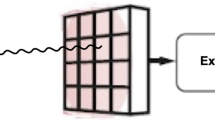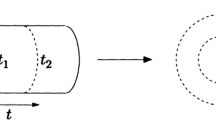Abstract
We make a detailed analysis of the spontaneous Z2-symmetry breaking in the two dimensional real ϕ4 theory with the tensor renormalization group approach, which allows us to take the thermodynamic limit easily and determine the physical observables without statistical uncertainties. We determine the critical coupling in the continuum limit employing the tensor network formulation for scalar field theories proposed in our previous paper. We obtain [λ/μ 2c ]cont. = 10.913(56) with the quartic coupling λ and the renormalized critical mass μc. The result is compared with previous results obtained by different approaches.
Article PDF
Similar content being viewed by others
Avoid common mistakes on your manuscript.
References
S.R. Coleman, There are no Goldstone bosons in two-dimensions, Commun. Math. Phys. 31 (1973) 259 [INSPIRE].
S.-J. Chang, The existence of a second order phase transition in the two-dimensional ϕ 4 field theory, Phys. Rev. D 13 (1976) 2778 [Erratum ibid. D 16 (1977) 1979] [INSPIRE].
M. Funke, U. Kaulfuss and H. Kummel, Approaching the critical region of two-dimensional ϕ 4 quantum field theory with post-Gaussian approximations, Phys. Rev. D 35 (1987) 621 [INSPIRE].
A. Harindranath and J.P. Vary, Solving two-dimensional ϕ 4 theory by discretized light front quantization, Phys. Rev. D 36 (1987) 1141 [INSPIRE].
A. Harindranath and J.P. Vary, Stability of the vacuum in scalar field models in 1 + 1 dimensions, Phys. Rev. D 37 (1988) 1076 [INSPIRE].
L. Polley and U. Ritschel, Second order phase transition in λϕ 4 in two-dimensions with non-Gaussian variational approximation, Phys. Lett. B 221 (1989) 44 [INSPIRE].
C.M. Bender, S. Pinsky and B. Van de Sande, Spontaneous symmetry breaking of ϕ 4 in (1 + 1)-dimensions in light front field theory, Phys. Rev. D 48 (1993) 816 [hep-th/9212009] [INSPIRE].
J.M. Hauser, W. Cassing, A. Peter and M.H. Thoma, Connected green function approach to ground state symmetry breaking in ϕ 4 in (1 + 1)-dimensions theory, Z. Phys. A 353 (1996) 301 [hep-ph/9408355] [INSPIRE].
T. Sugihara, Variational calculation of the effective action, Phys. Rev. D 57 (1998) 7373 [hep-th/9711129] [INSPIRE].
D. Lee, Introduction to spherical field theory, Phys. Lett. B 439 (1998) 85 [hep-th/9811117] [INSPIRE].
P.J. Marrero, E.A. Roura and D. Lee, A nonperturbative analysis of symmetry breaking in two-dimensional ϕ 4 theory using periodic field methods, Phys. Lett. B 471 (1999) 45 [hep-th/9906189] [INSPIRE].
D. Lee, N. Salwen and D. Lee, The diagonalization of quantum field Hamiltonians, Phys. Lett. B 503 (2001) 223 [hep-th/0002251] [INSPIRE].
H. Hansen, G. Chanfray, D. Davesne and P. Schuck, Random phase approximation and extensions applied to a bosonic field theory, Eur. Phys. J. A 14 (2002) 397 [hep-ph/0201279] [INSPIRE].
A.V. Vinnikov, C.-R. Ji, J.-I. Kim and D.-P. Min, The oscillator representation method for the (1 + 1-dimensional) ϕ 4 and ϕ 6 theory, hep-ph/0204114 [INSPIRE].
T. Sugihara, Density matrix renormalization group in a two-dimensional lambda ϕ 4 Hamiltonian lattice model, JHEP 05 (2004) 007 [hep-lat/0403008] [INSPIRE].
D. Schaich and W. Loinaz, An Improved lattice measurement of the critical coupling in ϕ 2 theory, Phys. Rev. D 79 (2009) 056008 [arXiv:0902.0045] [INSPIRE].
C. Wozar and A. Wipf, Supersymmetry breaking in low dimensional models, Annals Phys. 327 (2012) 774 [arXiv:1107.3324] [INSPIRE].
A. Milsted, J. Haegeman and T.J. Osborne, Matrix product states and variational methods applied to critical quantum field theory, Phys. Rev. D 88 (2013) 085030 [arXiv:1302.5582] [INSPIRE].
S. Rychkov and L.G. Vitale, Hamiltonian truncation study of the φ 4 theory in two dimensions, Phys. Rev. D 91 (2015) 085011 [arXiv:1412.3460] [INSPIRE].
P. Bosetti, B. De Palma and M. Guagnelli, Monte Carlo determination of the critical coupling in ϕ 2 theory, Phys. Rev. D 92 (2015) 034509 [arXiv:1506.08587] [INSPIRE].
A. Pelissetto and E. Vicari, Critical mass renormalization in renormalized ϕ 4 theories in two and three dimensions, Phys. Lett. B 751 (2015) 532 [arXiv:1508.00989] [INSPIRE].
M. Burkardt, S.S. Chabysheva and J.R. Hiller, Two-dimensional light-front ϕ 4 theory in a symmetric polynomial basis, Phys. Rev. D 94 (2016) 065006 [arXiv:1607.00026] [INSPIRE].
J. Elias-Miro, S. Rychkov and L.G. Vitale, High-precision calculations in strongly coupled quantum field theory with next-to-leading-order renormalized hamiltonian truncation, JHEP 10 (2017) 213 [arXiv:1706.06121] [INSPIRE].
J. Elias-Miro, S. Rychkov and L.G. Vitale, NLO Renormalization in the Hamiltonian Truncation, Phys. Rev. D 96 (2017) 065024 [arXiv:1706.09929] [INSPIRE].
M. Serone, G. Spada and G. Villadoro, λϕ 4 theory I: the symmetric phase beyond NNNNNNNNLO, JHEP 08 (2018) 148 [arXiv:1805.05882] [INSPIRE].
S. Bronzin, B. De Palma and M. Guagnelli, New Monte Carlo determination of the critical coupling in ϕ 42 theory, Phys. Rev. D 99 (2019) 034508 [arXiv:1807.03381] [INSPIRE].
M. Levin and C.P. Nave, Tensor renormalization group approach to 2D classical lattice models, Phys. Rev. Lett. 99 (2007) 120601 [cond-mat/0611687] [INSPIRE].
Z.-C. Gu and X.-G. Wen, Tensor-entanglement-filtering renormalization approach and symmetry protected topological order, Phys. Rev. B 80 (2009) 155131 [arXiv:0903.1069] [INSPIRE].
G. Evenbly and G. Vidal, Tensor network renormalization, Phys. Rev. Lett. 115 (2015) 180405 [arXiv:1412.0732].
S. Yang, Z.C. Gu and X.G. Wen, Loop optimization for tensor network renormalization, Phys. Rev. Lett. 118 (2017) 110504 [arXiv:1512.04938].
Z.-C. Gu, F. Verstraete and X.-G. Wen, Grassmann tensor network states and its renormalization for strongly correlated fermionic and bosonic states, arXiv:1004.2563 [INSPIRE].
Z.-C. Gu, Efficient simulation of Grassmann tensor product states, Phys. Rev. B 88 (2013) 115139 [arXiv:1109.4470].
Y. Liu et al., Exact blocking formulas for spin and gauge models, Phys. Rev. D 88 (2013) 056005 [arXiv:1307.6543].
J.F. Yu et al., Tensor renormalization group study of classical XY model on the square lattice, Phys. Rev. E 89 (2014) 013308 [arXiv:1309.4963] [INSPIRE].
A. Denbleyker et al., Controlling sign problems in spin models using tensor renormalization, Phys. Rev. D 89 (2014) 016008 [arXiv:1309.6623].
Y. Shimizu and Y. Kuramashi, Grassmann tensor renormalization group approach to one-flavor lattice Schwinger model, Phys. Rev. D 90 (2014) 014508 [arXiv:1403.0642] [INSPIRE].
J.F. Unmuth-Yockey, Y. Meurice, J. Osborn and H. Zou, Tensor renormalization group study of the 2d O(3) model, PoS(LATTICE 2014)325.
Y. Shimizu and Y. Kuramashi, Critical behavior of the lattice Schwinger model with a topological term at θ = π using the Grassmann tensor renormalization group, Phys. Rev. D 90 (2014) 074503 [arXiv:1408.0897] [INSPIRE].
Y. Shimizu and Y. Kuramashi, Berezinskii-Kosterlitz-Thouless transition in lattice Schwinger model with one flavor of Wilson fermion, Phys. Rev. D 97 (2018) 034502 [arXiv:1712.07808] [INSPIRE].
S. Takeda and Y. Yoshimura, Grassmann tensor renormalization group for the one-flavor lattice Gross-Neveu model with finite chemical potential, PTEP 2015 (2015) 043B01 [arXiv:1412.7855] [INSPIRE].
H. Kawauchi and S. Takeda, Tensor renormalization group analysis of CP (N − 1) model, Phys. Rev. D 93 (2016) 114503 [arXiv:1603.09455] [INSPIRE].
Y. Meurice et al., Tensor RG calculations and quantum simulations near criticality, PoS(LATTICE 2016)325 [arXiv:1611.08711] [INSPIRE].
R. Sakai, S. Takeda and Y. Yoshimura, Higher order tensor renormalization group for relativistic fermion systems, PTEP 2017 (2017) 063B07 [arXiv:1705.07764] [INSPIRE].
Y. Yoshimura et al., Calculation of fermionic Green functions with Grassmann higher-order tensor renormalization group, Phys. Rev. D 97 (2018) 054511 [arXiv:1711.08121] [INSPIRE].
Y. Kuramashi and Y. Yoshimura, Three-dimensional finite temperature Z 2 gauge theory with tensor network scheme, arXiv:1808.08025 [INSPIRE].
M.C. Bañuls et al., Tensor networks and their use for lattice gauge theories, PoS(LATTICE 2018)310 [arXiv:1810.12838] [INSPIRE].
Y. Shimizu, Analysis of the (1 + 1)-dimensional lattice ϕ 4 model using the tensor renormalization group, Chin. J. Phys. 50 (2012) 749.
D. Kadoh et al., Tensor network formulation for two-dimensional lattice \( \mathcal{N}=1 \) Wess-Zumino model, JHEP 03 (2018) 141 [arXiv:1801.04183] [INSPIRE].
S.G. Chung, Essential finite-size effect in the two-dimensional XY model, Phys. Rev. B 60 (1999) 11761 [cond-mat/9901314].
Y. Nishiyama, Strong-coupling-expansion analysis of the false-vacuum decay rate of the lattice ϕ 4 model in 1 + 1 dimensions, J. Phys. A 34 (2001) 11215 [cond-mat/0110195].
Y. Nishiyama, Quantum-fluctuation-induced repulsive interaction of a quantum string between walls, Phys. Rev. B 64 (2001) 064510 [cond-mat/0102123].
W. Lay and J. Rudnick, Analysis of a continuous field theory in two dimensions with use of the density matrix renormalization group, Phys. Rev. Lett. 88 (2002) 057203 [cond-mat/0105150].
S. Iblisdir, R. Orus and J.I. Latorre, Matrix product states algorithms and continuous systems, Phys. Rev. B 75 (2007) 104305 [cond-mat/0610530] [INSPIRE].
D. Kadoh and K. Nakayama, Direct computational approach to lattice supersymmetric quantum mechanics, Nucl. Phys. B 932 (2018) 278 [arXiv:1803.07960] [INSPIRE].
M. Abramowitz and I.A. Stegun, Handbook of mathematical functions: with formulas, graphs, and mathematical tables, Courier Corporation, U.S.A. (1965).
Z.C. Gu, M. Levin and X.G. Wen, Tensor-entanglement renormalization group approach as a unified method for symmetry breaking and topological phase transitions, Phys. Rev. B 78 (2008) 205116 [arXiv:0806.3509].
N. Nakamoto and S. Takeda, Computation of correlation functions by tensor renormalization group method, Sci. Rep. Kanazawa Univ. 60 (2016) 11.
L. Onsager, Crystal statistics. 1. A two-dimensional model with an order disorder transition, Phys. Rev. 65 (1944) 117 [INSPIRE].
S. Wang et al., Phase transitions of ferromagnetic Potts models on the simple cubic lattice, Chin. Phys. Lett. 31 (2014) 070503 [arXiv:1405.1179].
Open Access
This article is distributed under the terms of the Creative Commons Attribution License (CC-BY 4.0), which permits any use, distribution and reproduction in any medium, provided the original author(s) and source are credited.
Author information
Authors and Affiliations
Corresponding author
Additional information
ArXiv ePrint: 1811.12376
Rights and permissions
Open Access This article is licensed under a Creative Commons Attribution 4.0 International License, which permits use, sharing, adaptation, distribution and reproduction in any medium or format, as long as you give appropriate credit to the original author(s) and the source, provide a link to the Creative Commons licence, and indicate if changes were made.
The images or other third party material in this article are included in the article’s Creative Commons licence, unless indicated otherwise in a credit line to the material. If material is not included in the article’s Creative Commons licence and your intended use is not permitted by statutory regulation or exceeds the permitted use, you will need to obtain permission directly from the copyright holder.
To view a copy of this licence, visit https://creativecommons.org/licenses/by/4.0/.
About this article
Cite this article
Kadoh, D., Kuramashi, Y., Nakamura, Y. et al. Tensor network analysis of critical coupling in two dimensional ϕ4 theory. J. High Energ. Phys. 2019, 184 (2019). https://doi.org/10.1007/JHEP05(2019)184
Received:
Revised:
Accepted:
Published:
DOI: https://doi.org/10.1007/JHEP05(2019)184




